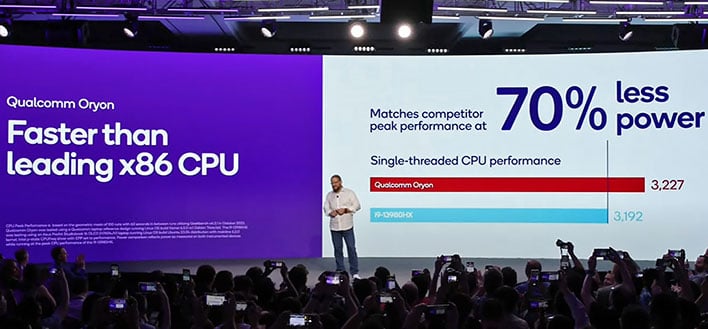Qualcomm Snapdragon X Elite To Deliver Performance-Per-Watt Leadership For PCs

One of the more exciting aspects of Qualcomm's Snapdragon family processors for Windows on Arm64 is that these laptop PCs are always connected (4G or 5G), and they can deliver stellar battery life. Just peruse any of our recent reviews and you can see that, for instance, the Lenovo Flex 5G has more than 24 hours of battery life with video playback. The downside for these systems historically has been performance versus x86 alternatives, with CPUs that have more in common with tablets and smartphones than full-fledged PCs but with serviceable experiences in a number of mainstream use cases.
However, thanks to the company's new Snapdragon X Elite series of processors, Qualcomm says that's all about to change. At it's Snapdragon Summit in Maui, HI today, the company lifted the veil on some details and performance expectations of its new laptop processor series based on its new Oryon CPU core technology.
When Qualcomm teased Snapdragon X a couple of weeks ago, the company said that the new Oryon architecture would revolutionize the way we use PCs. The company has been saying for a while now that it thinks it could even beat Apple at its own Arm-based game. Those are big words and a tall order, but let's look at what Qualcomm brought to the table here...
Snapdragon X Elite's Secret: The Oryon CPU
We've surmised and speculated that the Oryon CPU architecture was based on technology developed as a result of Qualcomm's acquisition of Nuvia more than 30 months ago. It takes time to design a chip, validate engineering samples and ultimately bring something to market, so the timing seems plausible, but Qualcomm isn't directly saying it. What it is saying, however, is that the Oryon CPU integrated into Snapdragon X delivers "up to two times faster" CPU performance compared to its x86 competition. We bet you didn't see that coming, and neither did we.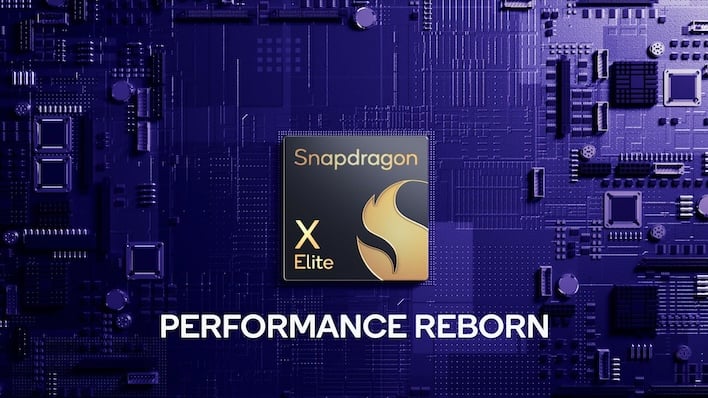
Built on a four-nanometer process, the Oryon CPU sports 12 high-performance cores running at 3.8 GHz. In situations that call for more single-threaded, or multi-threaded workload performance, a pair of those cores can boost up to 4.3GHz. All of Qualcomm's diagrams illustrate the Oryon CPU as three clusters with four CPU cores a piece, but we wouldn't read too much into that. The key takeaway is that this does not seem to be a big.LITTLE design, and all 12 cores seem relatively equal in Qualcomm's early documentation. And just to confirm, all of those cores are single-threaded only and do not support SMT (Simultaneous Multi-Threading).
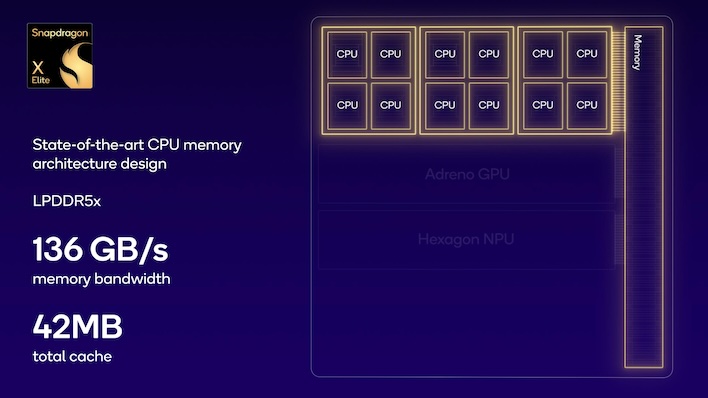
There's gobs of memory bandwidth on tap, too; the Snapdragon X Elite Compute Platform has support for LPDDR5x memory running at 8533 MT/s for a total aggregate bandwidth of 136 GB per second. That bandwidth funnels into 42 MB of total cache on the Snapdragon X Elite SoC, to keep those 12 cores all fed with data and instructions.
Snapdragon X Elite: High-End Performance With Low Power Draw
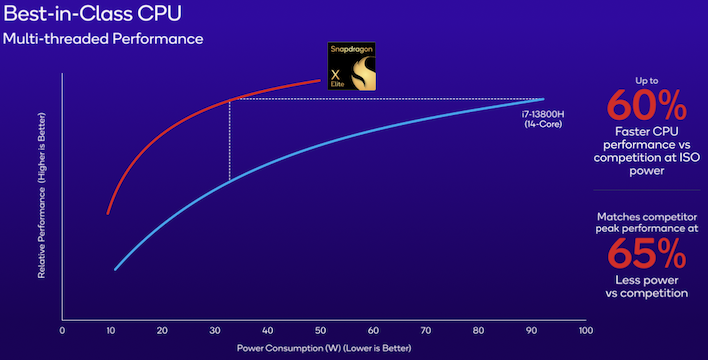
Using Geekbench 6.1's multi-threaded tests as a guide, Qualcomm says the Oryon CPU can deliver up to twice the performance of its competitor, and match a competing CPU's performance with 1/3 of the power required. To make it easier to digest, here are the specific performance claims as Qualcomm has laid them out:
- Beats Apple's M2 Max and Intel's Core i9-13980HX in single-threaded performance
- Reaches M2 Max's peak multi-threaded performance with 30% lower power consumption
- Reaches Core i9-13980HX peak multi-threaded performance with 70% lower power consumption
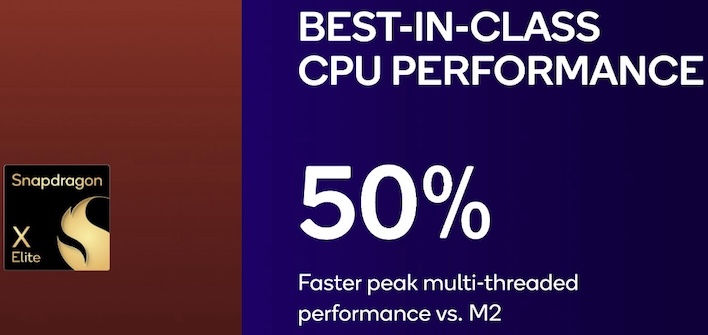
Those are the top dogs from both Intel's and Apple's laptop CPU families that Qualcomm is comparing, not some mid-tier CPU like a Core i5 or M2 Pro. Reaching peak multi-threaded performance compared to the M2 Max in a lower power envelope may not be too big of a surprise. Even the M2 Max in the current 16-inch MacBook Pro can only muster eight performance cores to Oryon's 12, and no doubt that's from where much of this multi-threaded advantage stems. Apple has largely stood still on the single-threaded performance front since it released the 2020 Mac mini, so competition in the Arm64 space is welcome indeed, especially for Windows laptops. Intel has Meteor Lake on the laptop horizon, but it's not here just yet so it's hard to draw any comparisons there.
Snapdragon X Elite Built for AI
Qualcomm has been pushing AI as a transformative technology and wants to bring the power of cloud machine learning to edge devices like its PCs. The Hexagon Neural Processing Unit (NPU) on-board Snapdragon X Elite should offload machine learning tasks that might otherwise run on a CPU onto dedicated accelerator for a massive uplift. The company says Oryon delivers 45 TOPS of throughput, along with INT4 support for even better efficiency, and thanks to its unified memory configuration, there's a larger pool for AI-focused workloads than most mobile SoCs provide.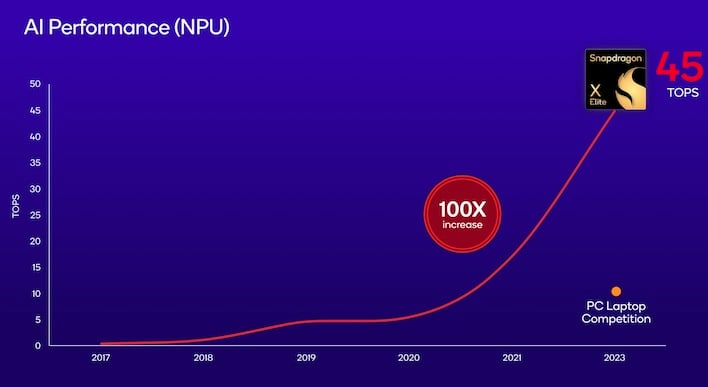
The Hexagon NPU is capable of running machine learning models with over 13 billion parameters directly on the device. All told, Qualcomm claims that 45 TOPS figure is 4.5x the performance of current CPUs found in laptops, and a 100-fold increase over laptop CPUs introduced since 2017. This is possible because of the nature of these low-precision workloads that are typically used for AI inference.

Snapdragon X Elite Adreno Graphics Performance And Sensing Hub
Big CPU performance and powerful machine learning aren't all that Qualcomm is promising that Snapdragon X Elite would deliver. Add to these claims the company's new Adreno graphics processor and the Sensing Hub. The Sensing Hub is a collection of sensors, voice processing, an always-sensing image signal processor, and always-on connectivity that is constantly feeding information to the AI engine and host processor. The company believes that this will transform the way we use our PCs, and revolutionize the way those PCs interface with us.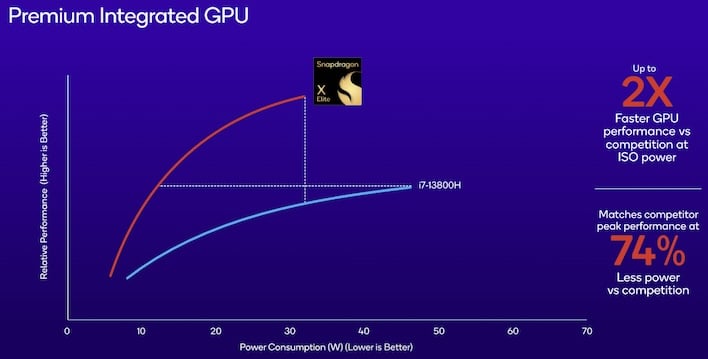
Qualcomm's Adreno graphics architecture is a mainstay across all of the company's SoC lineups from smartphones and tablets to PCs. However, the Adreno graphics engine on-board Snapdragon X Elite is, unsurprisingly, the company's most powerful yet, rated for 4.6 TFLOPS of compute performance. It can also drive 4K displays at 120Hz with full HDR10 support, too.
Again without naming names, Qualcomm says that the Snapdragon X Elite GPU can deliver performance anywhere from 80% higher to a full doubling of its PC competition, and match competing solutions' performance in 20-25% of the power envelope, based on 3DMark Wild Life Extreme benchmarks. This is of course as compared to other integrated graphics solutions in market.
Snapdragon Seamless: Cross-Device Cooperation
To go along with this newly-announced silicon, Qualcomm has also unveiled its Snapdragon Seamless initiative. The focus is to help multi-device users -- that's smartphone, tablet, and PC, for example -- have their devices work and communicate together to get work done in a, you guessed it, seamless experience. Qualcomm says its goal is for all devices based on its tech to be contextually aware of what users are doing across the device ecosystem, extend battery life through low-power, high-performance silicon, and build on the strength of its device management ecosystem.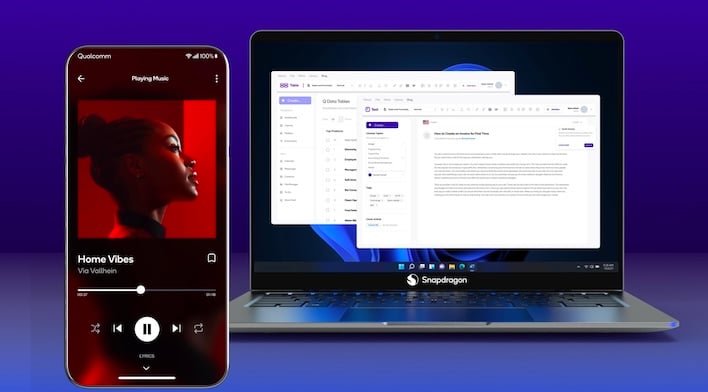
For example, devices supporting Snapdragon Seamless can share mice and keyboards seamlessly across PCs, phones, and tablets. Files and folders can be dragged from device to device. Ear buds can switch intelligently based on the priority of an audio source -- for example, using them with a PC until a phone rings, and then switch without any intervention so users can answer the call. If all of this sounds familiar, it's because Apple does these things between Macs, iPads, and iPhones with Air Drop for files, Universal Control for input devices, and the H2 controller found in current AirPods. Mac users have had this functionality, and it's high time PC users get the same level of control and interoperability.
Qualcomm says its Seamless initiative is all OS-independent, and will work with devices from a variety of manufacturers and platform vendors like Microsoft and Google. Xiaomi, Honor, Lenovo, and OPPO are all on board for devices with Seamless support. Devices that integrate with Qualcomm Snapdragon Seamless technology are expected to arrive globally as soon as late this year.
Snapdragon X Elite: Coming In 2024
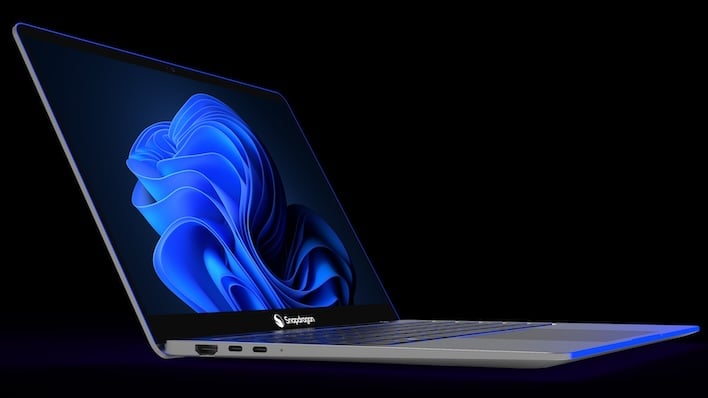
We're still a little ways off from seeing the Snapdragon X Elite Compute Platform shipping in PCs. The company says PCs powered by its latest platform SoC will come from leading OEMs sometime in mid-2024, and also says to watch out for Oryon to come to other platforms including smartphones and tablets. Of course, AMD, Intel, and even Apple aren't sitting still, so it will be interesting to see where the Oryon CPU lands once we can get our hands on it for testing. And you can bet we will, so stay tuned.


